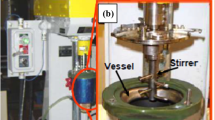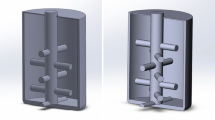Abstract
In this study, we formulate a mathematical model that can be implemented to calculate the amount of strain energy both introduced to (U i) and stored in (U s) metal powders during mechanical milling. The theoretical analysis presented in this study proposes that the strain energy is primarily induced by normal and shear strains, and moreover, that the contributions from torsion can be neglected. This theoretical framework was implemented to evaluate the influence of various mechanical milling processing parameters on U i and U s. The calculated results show that the magnitude of U i increases with increases in the following processing parameters: attritor diameter, impeller’s rotational frequency, and ball-to-powder mass ratio, and the magnitude of U i increases with a decrease in diameter of the milling media. The percentage of the shear strains’ contribution to the total U i is insensitive to the mechanical milling processing parameters, varying within the range of 35 pct to 42 pct. The calculated magnitude of U s ranges from a few to a few tens of joules per gram, which is three to four orders of magnitude lower than that of the calculated U i. Although with respect to the mechanical milling processing parameters, the calculated U s has trends similar to those for U i, the changing rates of U s are much lower than those for U i.







Similar content being viewed by others
Abbreviations
- C :
-
ball-to-powder mass ratio
- F :
-
impeller’s rotational frequency
- f :
-
frequency of collision between balls
- K, n :
-
shear work-hardening factor and index, respectively
- m :
-
mass of powders mechanically milled
- N, M :
-
total number and mass of milling balls
- R :
-
radius of the milling vessel
- r E, h, V E :
-
radius, height, and volume of cylindrical entrapped powders, respectively
- r B, ρ B, and E B :
-
radius, density, and Young’s modulus of balls, respectively
- t :
-
milling time
- t c :
-
duration of an individual collision
- \( u_{{{\text{E}},\sigma_{z} }} ,\,u_{{{\text{E}},\sigma_{r} }} \) :
-
strain energy introduced to powders during an individual collision by σ z and σ r , respectively
- u s :
-
shear strain energy introduced to powders during an individual collision
- U i :
-
strain energy introduced to powders per unit mass
- U s :
-
strain energy stored in powders per unit mass
- V m :
-
volume of ball milling
- x :
-
distance away from the rotational center
- Y :
-
uniaxial tensile yield strength of powders
- ε :
-
normal strain of entrapped powders along the thickness reduction direction
- σ z , σ r , σ θ :
-
three-dimensional compressive stresses in a small unit cell from the cylinder of entrapped powder aggregate
- γ :
-
shear strain
- λ :
-
average free path between balls
- μ :
-
coefficient of friction between powder and ball
- ρ P :
-
powder density
- Δh :
-
dimensional reduction of entrapped powders during collision
- Δv :
-
two colliding balls’ velocity difference
- Δv n, Δv s :
-
components of the two colliding balls’ velocity difference parallel and perpendicular to the direction joining the two balls’ centers, respectively
- Δω :
-
two colliding balls’ rotational speed difference
- v max :
-
maximum velocity of the balls at x
- \( \overline{\Updelta v} (x) \) :
-
average velocity difference between the balls at x
- \( \overline{\overline{\Updelta v}} \) :
-
overall average velocity difference of all balls
- \( \overline{\overline{{\Updelta v_{n} }}} ,\,\overline{\overline{{\Updelta v_{s} }}} \) :
-
normal and shear components of overall average velocity difference
- \( \overline{\overline{{\Updelta v_{sx} }}} ,\,\overline{\overline{{\Updelta v_{sy} }}} \) :
-
subcomponents of shear component of overall average velocity difference along X and Y axis directions
- χ :
-
the ratio of the strain energy stored in powders per unit mass to the strain energy introduced to powders per unit mass
References
V.M. Segal: Mater. Sci. Eng. A, 1995, vol. 197, pp. 157–64.
R.Z. Valiev, R.K. Islamgaliev, and I.V. Alexandrov: Progr. Mater. Sci., 2000, vol. 45, pp. 103–89.
Y. Saito, H. Utsunomiya, N. Tsuji, and T. Sakai: Acta Mater., 1999, vol. 47, pp. 579–83.
T. Sakai, A. Belyakov, and H. Miura: Metall. Mater. Trans. A, 2008, vol. 39A, pp. 2206–14.
C.C. Koch: Nanostructured Mater., 1997, vol. 9, pp. 13–22.
H. Fecht, E. Hellstern, Z. Fu, and W.L. Johnson: Metall. Trans. A, 1990, vol. 21A, pp. 2333–37.
L. Lu and M.O. Lai: Mechanical Alloying, Kluwer Academic Publishers, Norwell, MA, 1998.
C. Suryanarayana: Progr. Mater. Sci., 2001, vol. 46, pp. 1–184.
J. Eckert, J.C. Holzer, C.E. Krill III, and W.L. Johnson: J. Mater. Res., 1992, vol. 7, pp. 1751–61.
D.L. Zhang: Progr. Mater. Sci., 2004, vol. 49, pp. 537–60.
M. Magini and A. Iasonna: Mater. Trans. JIM, 1995, vol. 36, pp. 123–33.
A. Iasonna and M. Magini: Acta Mater., 1996, vol. 44, pp. 1109–17.
M. Magini, A. Iasonna, and F. Padella: Scripta. Mater., 1996, vol. 34, pp. 13–19.
D. Maurice and T.H. Courtney: Metall. Mater. Trans. A, 1996, vol. 27A, pp. 1973–79.
B. Aikin and T.H. Courtney: Metall. Trans. A, 1993, vol. 24A, pp. 2465–71.
M. Abdellaoui and E. Gaffet: Acta Mater., 1996, vol. 44, pp. 725–34.
M. Abdellaoui and E. Gaffet: Acta Metall. Mater., 1995, vol. 43, pp. 1087–98.
R. Watanabe, H. Hashimoto, and G.G. Lee: Mater. Trans. JIM, 1995, vol. 36, pp. 102–09.
E.V. Shelekhov, V.V. Tcherdyntsev, L.Y. Pustov, S.D. Kaloshkin, and I.A. Tomilin: Mater. Sci. Forum, 2000, vols. 343–343, pp. 603–08.
P. Le Brun, L. Froyen, and L. Delaey: Mater. Sci. Eng. A, 1993, vol. 161, pp. 75–82.
M.P. Dallimore and P.G. McCormick: Mater. Trans. JIM, 1996, vol. 37, pp. 1091–98.
D.R. Maurice and T.H. Courtney: Metall. Trans. A, 1990, vol. 21A, pp. 289–303.
J.N. Harris: Mechanical Working of Metals, Pergamon Press, Oxford, U.K., 1983.
F.J. Humphreys and M. Hatherly: Recrystallization and Related Annealing Phenomena, 2nd ed., Elsevier, Boston, MA, 2004.
F.A. Mohamed: Acta Mater., 2003, vol. 51, pp. 4107–19.
D. Witkin and E.J. Lavernia: Progr. Mater. Sci., 2006, vol. 51, pp. 1–60.
D. Witkin, B.Q. Han, and E.J. Lavernia: J. Mater. Res., 2005, vol. 20, pp. 2117–26.
G. Lucadamo, N.Y.C. Yang, C.S. Marchi, and E.J. Lavernia: Mater. Sci. Eng. A, 2006, vol. 430, pp. 230–41.
D. Witkin, B.Q. Han, and E.J. Lavernia: J. Mater. Eng. Perform., 2005, vol. 14, pp. 519–27.
E.J. Lavernia, B.Q. Han, and J.M. Schoenung: Mater. Sci. Eng. A, 2008, vol. 493, pp. 207–14.
Y. Li, W. Liu, V. Ortalan, W.F. Li, Z. Zhang, R. Vogt, N.D. Browning, E.J. Lavernia, and J.M. Schoenung: Acta Mater., 2010, vol. 58, pp. 1732–40.
V.L. Tellkamp, S. Dallek, D. Cheng, and E.J. Lavernia: J. Mater. Res., 2001, vol. 16, pp. 938–44.
J.R. Davis: Aluminum and Aluminum Alloys, ASM International, Materials Park, OH, 1993.
J.R. Davis: Stainless Steels, ASM International, Materials Park, OH, 1994.
A.D. Sarkar: Friction and Wear, Academic Press, New York, NY, 1980.
A.P. Newbery, B. Ahn, T.D. Topping, P.S. Pao, S.R. Nutt, and E.J. Lavernia: J. Mater. Process. Tech., 2008, vol. 203, pp. 37–45.
S. Cheng, J.A. Spencer, and W.W. Milligan: Acta Mater., 2003, vol. 51, pp. 4505–18.
F. Zhou, X.Z. Liao, Y.T. Zhu, S. Dallek, and E.J. Lavernia: Acta Mater., 2003, vol. 51, pp. 2777–91.
W.Q. Cao, A. Godfrey, N. Hansen, and Q. Liu: Metall. Mater. Trans. A, 2009, vol. 40A, pp. 204–14.
F. Haessner and J. Schmidt: Acta Metall. Mater., 1993, vol. 41, pp. 1739–49.
N.R. Bauld: Mechanics of Materials, PWS Publishers, Boston, MA, 1986.
Acknowledgments
The authors acknowledge the financial support from the U.S. Army Research Laboratory Cooperative Agreement No. W911NF-08-2-0028. Y.J. Lin acknowledges the financial support from the One Hundred Talents Project of Hebei Province, China and the Research Program of Department of Education, Hebei Province, China (Project No. ZH2011111).
Author information
Authors and Affiliations
Corresponding author
Additional information
Manuscript submitted October 4, 2011.
Appendices
Appendix A
1.1 The Strain Energy Contributed by the Normal Stresses σ z and σ r
A small unit cell is taken from the entrapped powder aggregate, which is subjected to three-dimensional compressive stresses σ z , σ r , and σ θ,[23] as shown in Figure 2. Assuming axisymmetric flow, ε r = ε θ , where ε r and ε θ are normal strains corresponding to σ r and σ θ , respectively, and hence, σ r = σ θ . Using the von Mises yield criterion, σ r − σ z = Y. According to Reference 23
where r is the distance away from the center of the entrapped powder aggregate that is assumed as cylindrical geometry. The strain energy introduced by σ z is analyzed by considering a ring of r in the distance away from the center, dr in width and h in thickness. The work on the ring contributed by σ z is σ z · 2πrdr · Δh. Therefore, the strain energy introduced to the entrapped powders by σ z can be expressed as
The strain energy introduced by σ r is analyzed by considering the aforementioned ring. The elongation along radial direction per unit length is \( \sqrt {h/(h - \Updelta h)} - 1 \). Thus, the work on the ring contributed by σ r is \( \sigma_{r} \cdot 2\pi rh \cdot [\sqrt {h/(h - \Updelta h)} - 1]dr \), and the strain energy introduced by σ r can be evaluated
Appendix B
2.1 Analysis of Shear Strains during an Individual Collision Between Balls
A relationship between a principal normal strain of a point ε and the normal and shear strains of the point in a given orthogonal coordinate system ε x , ε y, ε z , γ xy = γ yx , γ xz = γ zx and γ yz = γ zy is given by[41]
where l, m, and n are directional cosines of the principal normal strain (l 2 + m 2 + n 2 = 1). The shear strains can be obtained from Eq. [B1]:
According to Eq. [8], normal strain is a function of properties of ball and powder, in addition to the component of the two balls’ velocity difference along the normal strain, which is described by
where Δv nx , Δv ny, Δv nz , and Δv np are the components of the two balls’ velocity difference along three coordinate axes x, y, and z, and along the principal normal strain direction, respectively. Inserting Eq. [B3] into Eq. [B2] yields:
Equation [B4] expresses that a shear strain is directly proportional to C, ρ P, ρ −0.6B , and E −0.4B like normal strain. Based on Eq. [B4], the shear strain seems to be directly proportional to the components of the two balls’ velocity difference. Thus, the shear strains are assumed directly proportional to the components of the two balls’ velocity difference along the corresponding shear strain directions. It is challenging to determine the constant that correlates γ to Cρ P ρ −0.6 B E −0.4 B Δv 0.8 s . To render this problem tractable, it is assumed that the constant is 5.226, a value determined for a normal strain (see Eq. [8]).
Rights and permissions
About this article
Cite this article
Lin, Y., Yao, B., Zhang, Z. et al. Strain Energy During Mechanical Milling: Part I. Mathematical Modeling. Metall Mater Trans A 43, 4247–4257 (2012). https://doi.org/10.1007/s11661-012-1223-4
Published:
Issue Date:
DOI: https://doi.org/10.1007/s11661-012-1223-4




